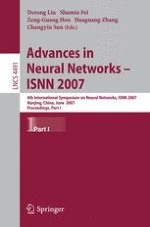2007 | Buch
Advances in Neural Networks – ISNN 2007
4th International Symposium on Neural Networks, ISNN 2007, Nanjing, China, June 3-7, 2007, Proceedings, Part I
herausgegeben von: Derong Liu, Shumin Fei, Zeng-Guang Hou, Huaguang Zhang, Changyin Sun
Verlag: Springer Berlin Heidelberg
Buchreihe : Lecture Notes in Computer Science
